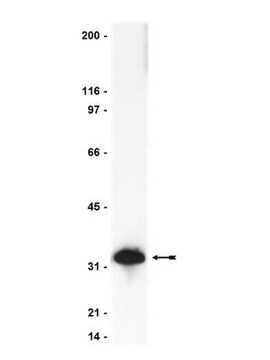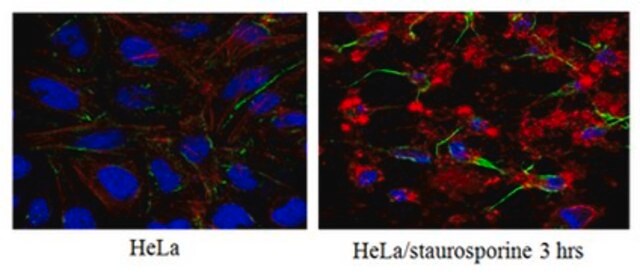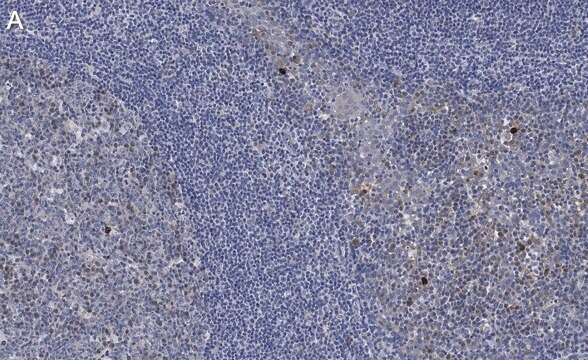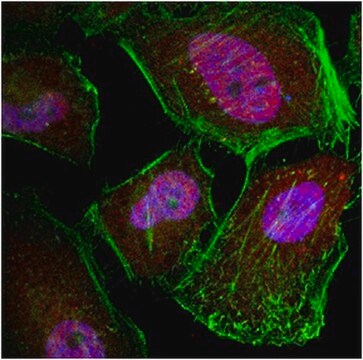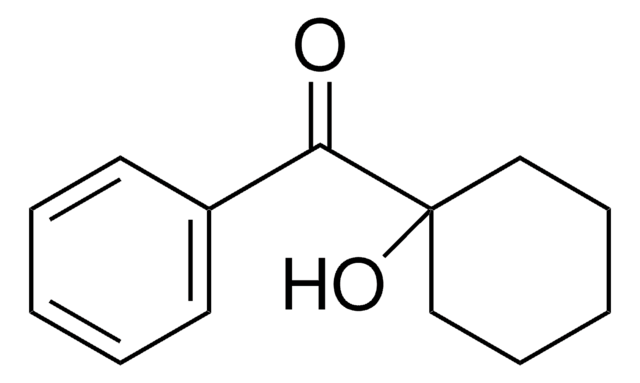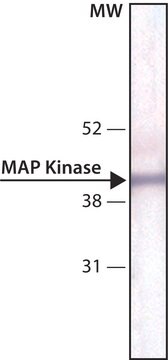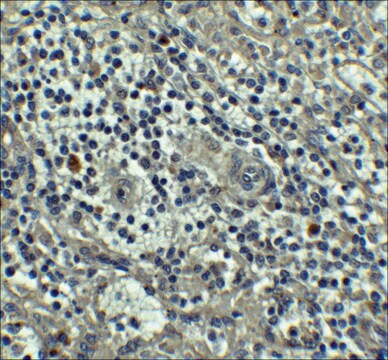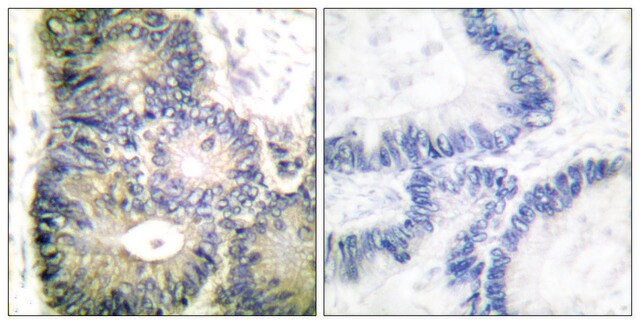C5737
Monoclonal Anti-Caspase 3 antibody produced in mouse
clone 84803.111, purified immunoglobulin, lyophilized powder
Sinónimos:
Anti-Apopain, Anti-CPP32, Anti-Yama
Iniciar sesiónpara Ver la Fijación de precios por contrato y de la organización
About This Item
Productos recomendados
origen biológico
mouse
Nivel de calidad
conjugado
unconjugated
forma del anticuerpo
purified immunoglobulin
tipo de anticuerpo
primary antibodies
clon
84803.111, monoclonal
Formulario
lyophilized powder
reactividad de especies
human
técnicas
western blot: 1.0 μg/mL using human Jurkat cells
isotipo
IgG2b
Nº de acceso UniProt
temp. de almacenamiento
−20°C
modificación del objetivo postraduccional
unmodified
Información sobre el gen
human ... CASP3(836)
Categorías relacionadas
Descripción general
CASP3 (caspase 3) is a cysteine protease belonging to the caspase protein family, and is related to interleukin-1β-converting enzyme (ICE). It is the human homologue of Caenorhabditis elegans Ced-3 protein. This protein forms a key element of apoptosis.
Especificidad
Detects recombinant human precursor caspase 3 and the 18 kDa form produced during apoptosis.
Inmunógeno
recombinant 18 kDa subunit, amino acids 29-175, of human caspase 3.
Acciones bioquímicas o fisiológicas
CASP3 (caspase 3) is an essential protein of apoptosis, which includes multiple death-inducing signals, and caspase 3 functions at the last steps of programmed cell death. This protein is shown to be expressed in esophageal squamous cell carcinoma (ESCC), and its down-regulation is related to increased malignancy and reduced overall survival. Its expression in metastatic lymph nodes (LN) might serve as a marker for poor survival prognosis in patients with resected ESCC and metastasis to LN. Studies in multiple cancers such as, gastric, colorectal, ovarian and cervical cancers show that aberrant expression of this gene is linked with cancer progression and aggressive behavior. It might have potential as a marker to determine the prognosis of the above cancers.
Forma física
Lyophilized from a 0.2 μm filtered solution in 0.01 M phosphate buffered saline with 5% trehalose.
Cláusula de descargo de responsabilidad
Unless otherwise stated in our catalog or other company documentation accompanying the product(s), our products are intended for research use only and are not to be used for any other purpose, which includes but is not limited to, unauthorized commercial uses, in vitro diagnostic uses, ex vivo or in vivo therapeutic uses or any type of consumption or application to humans or animals.
¿No encuentra el producto adecuado?
Pruebe nuestro Herramienta de selección de productos.
Opcional
Referencia del producto
Descripción
Precios
Código de clase de almacenamiento
11 - Combustible Solids
Clase de riesgo para el agua (WGK)
WGK 1
Punto de inflamabilidad (°F)
Not applicable
Punto de inflamabilidad (°C)
Not applicable
Elija entre una de las versiones más recientes:
¿Ya tiene este producto?
Encuentre la documentación para los productos que ha comprado recientemente en la Biblioteca de documentos.
Los clientes también vieron
Qian Hu et al.
International journal of clinical and experimental pathology, 7(8), 5057-5070 (2014-09-10)
Emerging evidence has indicated that apoptotic cells have a compensatory effect on the proliferation of neighboring cells. Recent studies have shown that apoptotic tumor cells stimulate the repopulation of tumors from a small number of surviving cells by cleaved caspase-3
Xiu-Shen Wang et al.
World journal of gastroenterology, 20(15), 4414-4420 (2014-04-26)
To assess whether differential expression of caspase-3 in paired metastatic lymph nodes (LNs) is prognostic of survival in patients with resectable esophageal squamous cell carcinoma (ESCC). Capases-3 expression was evaluated immunohistochemically in 122 pairs of primary ESCCs and regional metastatic
Tingting Gu et al.
Oncology letters, 14(6), 6815-6822 (2018-02-10)
The present study explored the expression of tetraspanin 1 (TSPAN1) in esophageal carcinoma (EC) and its association with clinicopathological factors. TSPAN1 small interfering RNA (siRNA) was designed to target the TSPAN1 gene in Eca-109 cells in order to explore the
Chuandong Zhu et al.
Oncology letters, 15(4), 4221-4228 (2018-03-20)
The high atomic number of gold nanoparticles (GNPs) enables them to offer potential as practical and efficient radiosensitizing agents for cancer radiotherapy applications. In the present study, it was demonstrated that GNPs can significantly modulate the irradiation response of hepatocellular
Javier Marqués et al.
Antioxidants (Basel, Switzerland), 11(11) (2022-11-12)
NADPH oxidases (NOX) constitute the main reactive oxygen species (ROS) source in blood vessels. An oxidative stress situation due to ROS overproduction can lead into endothelial dysfunction, a molecular mechanism that precedes cardiovascular diseases (CVDs) such as atherosclerosis, myocardial infarction
Nuestro equipo de científicos tiene experiencia en todas las áreas de investigación: Ciencias de la vida, Ciencia de los materiales, Síntesis química, Cromatografía, Analítica y muchas otras.
Póngase en contacto con el Servicio técnico
